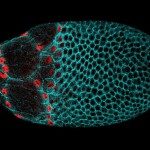Lien vers Pubmed [PMID] – 15930102
Development 2005 Jul;132(13):3003-14
The homeobox-containing genes Msx1 and Msx2 are highly expressed in the limb field from the earliest stages of limb formation and, subsequently, in both the apical ectodermal ridge and underlying mesenchyme. However, mice homozygous for a null mutation in either Msx1 or Msx2 do not display abnormalities in limb development. By contrast, Msx1; Msx2 double mutants exhibit a severe limb phenotype. Our analysis indicates that these genes play a role in crucial processes during limb morphogenesis along all three axes. Double mutant limbs are shorter and lack anterior skeletal elements (radius/tibia, thumb/hallux). Gene expression analysis confirms that there is no formation of regions with anterior identity. This correlates with the absence of dorsoventral boundary specification in the anterior ectoderm, which precludes apical ectodermal ridge formation anteriorly. As a result, anterior mesenchyme is not maintained, leading to oligodactyly. Paradoxically, polydactyly is also frequent and appears to be associated with extended Fgf activity in the apical ectodermal ridge, which is maintained up to 14.5 dpc. This results in a major outgrowth of the mesenchyme anteriorly, which nevertheless maintains a posterior identity, and leads to formation of extra digits. These defects are interpreted in the context of an impairment of Bmp signalling.


